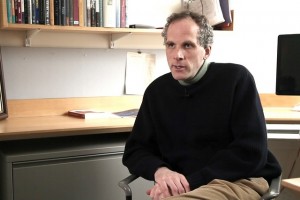Circadian Rhythm
Neuroscientist Russel Foster on the sleep-wake cycle, photosensitive retinal ganglion cells, and SCRD
What is special about the structure of the brain compared to other organs? What are the obstacles to mapping all the neuron connections in the human brain? Why don’t we have a clear idea about how our brains work? These and other questions are answered by Jeremy R. Knowles Professor of Molecular and Cellular Biology at Harvard University Jeff Lichtman.
[The question is] actually quite old. People have been interested how brains work at the level of its deep structure for over a hundred years. It’s been clear that the brain is made up of nerve cells that are connected together in very complicated patterns. But the approach of trying to figure out exactly how all the brain cells are connected to each other, a kind of mapping of the entire brain, has been really impossible until relatively recently. And now it seems conceivable, at least, that one can get a sense of how brains are organized at this deep level by mapping out all the connections between nerve cells. And this is an “omics” like genomics is the “omics” of all the genes that make up the instruction book to make cells and organisms. The “omics” of the connections of the brain would be the mapping of all those wires and that would be connectomics.
The brain however is very different, because although I could lose a lung and survive, I could lose a half of my liver, but if I take out a half of your brain or anyone’s brain you’ll notice a difference immediately. And that’s because brains are made up of a much more diverse set of cellular organizations. The front of your brain, the frontal cortex, for example, that’s completely different things than the back in the brain, the occipital cortex. The spinal cord has a completely different role in your body than the cerebral cortex. And the cerebellum has a different role and a place called the amygdala has a different role.
Every single part of the brain has its own unique function and, surprisingly, its own unique cell types. And those cells are wired together in unique ways everywhere. So you can’t simply understand the whole brain by understanding one little piece. You actually have to understand every little piece, and every little piece is different from every other little piece.
There’s no other aspect of our body that’s like that. There’s just nothing like it anywhere else. And this has been a tremendous problem for understanding brains. Not only how normal brains work, but how brains work poorly in cases of a brain disease. And I mention this, because for most organ systems most diseases can be traced back to an abnormality in the biochemistry or the structure of the cells that make up some part of the motif.
So for most kidney diseases, most lung diseases, most liver diseases you can trace it back in the field of pathology – it is the field where people look at these abnormal organs and see something wrong. The field of neuropathology is very useful for things like tumors of the brain. But the neuropathology of schizophrenia, which is one percent of the population, or autism – just tremendous number of children with this disorder, or the wide range of other psychiatric or behavioral disorders – there is no pathology. And so some people think the brains must be normal at the level of the cells. That’s not the case. The case is actually we just don’t know, because no one has ever really looked at enough detail to see what the physical structure of the brain is at those high levels. Because it just seems insurmountable amount of complexity and for many years it has been. But now thanks to automated technologies of industrializing the looking at tissue, it becomes conceivable for the first time, I think, to imagine really having of cellular substrate of every single part of the nervous system. And that’s what connectomics ultimately helps to do.
The idea that the brain is made up of nerve cells has a history that began in around 1870-1873 – about when a very, very talented Italian histologist named Camillo Golgi. He was 30 years old and he was playing around apparently in his kitchen with a bunch of chemicals, and he mixed them together in a particular way that allowed the brain tissue to be stained in an extremely inefficient way. Normally you’d think an inefficient stain would be the worst stain in the world, but that was the magic of his stain. And to this day it is not exactly clear why it works this way, but the Golgi stain that now has his name – and he got the Nobel prize for this work, sо it was important, to be sure – was a technique that causes the crystallization of a dark reaction product in a very small subset of nerve cells. But once the dark reaction product started to crystallize it filled up the entire cell. But the vast majorities of cells were unlabeled. So you could see a brain cell in a sea of unlabeled cells, and so for the first time you could see the full complexity of these individual brain cells.
And that kind of worldview has kind of dominated the way we have thought about brains since the time of his discoveries, and he shared the Nobel prize with Golgi actually for his discoveries with that technique. The strength of that approach was the profound insight that the brain is made up of nerve cells that have very peculiar shapes, there’s a wide range of them and they have very particular connection patterns. And the weakness of that approach was – unfortunately a very small subset of nerve cells were stained.
So you couldn’t say how many different axons converged on the dendrite of a cell or how many different target cells a particular axon innervated. And its only with modern techniques that allow us to see all the cells and all the connections that one can kind of fill in this sparse Golgi-like stain now with the complete rendering of what’s going on in the brain.
The big problem with a field like this is that there is still a huge chasm between what we know about illnesses of behavior, whether they’re learning disorders or psychiatric illnesses, and what we know about the structure of the brain. So we don’t even in normal brains have a good map of how brain cells are arranged relative to each other, so it’s not surprising, I guess, that we don’t yet have any really good ideas at the level of fine circuitry about what is different in the brains for many behavioral disorders and psychiatric diseases.
Brains are being mapped extremely well now with tools like functional magnetic resonance imaging or PET scanning. These are remarkable tools and they can non-invasively image entire brains at a resolution of about one cubic millimeter – is what each little spot of date is, so the brain is rendered at that resolution.
Within one cubic millimeter of brain tissue we could generate 2000 terabytes of data, 2 petabytes of data per cubic millimeter.
This is a big data problem, because a human brain is about a million cubic millimeters. So that would be about 2 million thousand terabytes, or two million petabytes, which is comparable to the digital content of the world! It’s like big number, so one of the real drawbacks of connectomics is it’s a big data problem in an enormous big data, even big data underrepresents how big this dataset is. So that is one of our problems.
I am an optimist to be sure, and we are pushing as hard as we can to make this field a reality. Between the time we started and now we’ve had a speedup of several thousand fold, and when our new microscope comes – that will be another speed up of over fifty fold. And these speedups mean that we are moving in the right direction. We’re very hopeful that for small animals we will have full wiring diagrams at some time soon…
So human brain is a harder problem, but there may be reasons why after a while it’ll get boring, just as no one would do a full reconstruction of a kidney, because once you understand what the motifs are there’s no need to do more. It’s possibly that the human brain, at some point, we would understand it well enough that we’d say: “We don’t need to do anymore, we’ve got the picture.” That’s my hope.

Neuroscientist Russel Foster on the sleep-wake cycle, photosensitive retinal ganglion cells, and SCRD

Biologist Ali Khademhosseini on tissue engineering, drug testing, and nanomedicines for cancer

Harvard Medical School Prof. David Jones on personalized medicine, patients’ lifestyle, and genetic factors of...